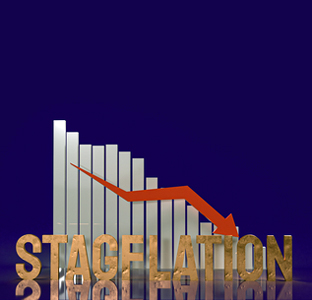What is Stagflation?
Stagflation is a combination of the following economic conditions: stagnation or the economic growth rate slowing, high unemployment, and high rates of inflation (rising prices of goods and services).
Causes of stagflation?
Stagflation does not fit neatly into most widely accepted principles of economic theory. Normally slow economic growth prevents inflation as demand for products and services falls in addition to prices. Disruptive government policies make stagflation an unusual economic event. Problems arise for governments because most policies designed to reduce inflation raise unemployment and the other way around.
One cause of stagflation occurs when an economy faces a supply shock, for example a rapid increase in the price of oil (think the stagflation of the 1970’s) or other commodities (think today). Prices tend to rise as economic growth slows – production becomes more costly and less profitable.
A second cause of stagflation is the government instituting policies that are detrimental to industry while increasing the money supply too quickly (think today).
These two things would probably have to occur at the same time because policies that slow economic growth do not usually cause inflation, and policies that cause inflation do not usually slow economic growth.
Why is stagflation undesirable?
As an economy contracts, job opportunities shrink. Higher levels of unemployment mean less money for consumers to spend. But, the difference between a recession (defined as two quarters of negative Gross Domestic Product), and stagflation is that the inflation rate rises too. As goods and services become more expensive, the money consumers do have is worth less. Stagflation is a rare phenomenon, but it can be dangerous because consumers incomes are decreasing at the same time as their costs are increasing – they are being squeezed from both sides.
What is the cure for stagflation?
To be clear, like viruses, there is no definitive cure for stagflation. The consensus among economists is that productivity needs to be increased to a point where it would lead to higher growth without adding more inflation. This would then make it easier for the Federal Reserve (FED) to hopefully tighten monetary policy to eradicate the rampant inflation part of stagflation. This is no easy feat – so the goal and the key to preventing stagflation is to be extremely proactive in avoiding it.
Market Commentary:
The stock/bond relationship appears to be changing. High inflation periods, such as 1967 – 1998, saw stock and bond returns positively correlated — bond yields went up/bond prices down and stock prices went down. High inflation concerns were the driver of this relationship. For the last several years, when markets have not been concerned with an inflation threat — bond yields declined/bond prices up and stock prices went up — the stock/bond relationship has been negatively correlated.
The markets so far in 2021 seem confused about inflation. The FEDs official communiques keep telling us that inflation is transitory, but we ”every-day” people know differently. Once price increases take hold, they usually do not go back down (think food, health care and wages for example). The first few months of the year, long term interest rates rose, due to market players inflation concerns. Recently, long term rates have come down, as bond investors changed their minds and embraced “the inflation is transitory” thinking. If all investors, particularly bond institutional investors “come together on the same page” and believe that inflation is not transitory, rates will move higher – how much we do not know. So, what to do? There is good news in all of this – there are investments that tend to do well in inflationary environments. Commodity prices, which have already moved higher (and backed off highs recently), dividend paying stocks, and good quality companies with good balance sheets tend to fare well in inflationary environments. We are/have been positioning our portfolios in the direction of an inflation environment taking hold.
We appreciate and thank you for the trust and confidence you have placed in Occam Capital® Management, LLC.

